NASA
 Seal | |
 | |
 Flag | |
| Agency overview | |
|---|---|
| Formed | July 29, 1958 |
| Preceding agency | |
| Jurisdiction | US Federal Government |
| Headquarters | Two Independence Square,Washington, D.C., United States 38°52′59″N77°0′59″W/ 38.88306°N 77.01639°W |
| Motto | For the Benefit of All[2] |
| Employees | 17,219(2019)[3] |
| Annual budget | |
| Agency executives |
|
| Website | NASA.gov |
TheNational Aeronautics and Space Administration(NASA) is anindependentagencyof theUnited States Federal Governmentthat deals withspace explorationandaeronautics,the operating and designing ofplanes.[note 1]NASA has had many successful missions, for example theISS,andApollo 11,which put the first man onthe Moonin 1969. NASA was founded on July 29, 1958.[7]NASA'smottois: "For the Benefit of All".[2]Since April of 2021,Bill Nelson,former Senator from Florida, has served as NASA Administrator.
Founding and the Sputnik crisis[change|change source]
NASA was preceded by the "National Advisory Committee for Aeronautics"(NACA). NACA was a US federal agency founded on March 3, 1915 to undertake, promote, and institutionalizeaeronauticalresearch. On October 1, 1958 the agency was dissolved, and its assets and personnel transferred to the newly created National Aeronautics and Space Administration (NASA).[8]NASA was founded to compete with theSoviet Unionin thespace race.In the 1950s and 1960s there was a space race between theUSand theSoviet Union- now calledRussia.The Soviets started first launchingSputnik 1,the first object made by people to go intoorbit,in October 1957. The Americans were worried by this. It caused acrisisknown as the Sputnik Crisis as the Americans feared the Russians might start building weapons in space. This all happened at a time called theCold Warwhen the US and the Soviet Union were always very close towar.
Space flight programs[change|change source]
Project Mercury (1958–1963)[change|change source]

Originally NASA was very small with only fourlaboratoriesand around eighty people working there.Germanengineersand scientists led byWernher von Braunhelped them buildrockets.They had helped build theV-2missile in Germany duringWorld War II[9]and theRedstonemissile for theUS Armyafterwards. Their Army missile laboratory was transferred to NASA.
In 1960 they set up the Mercury project. The Mercury Projectspace missionswere designed by NASA, mostly to test ifhumanscould survive inspace.After they proved it was possible for people to live in space they moved on.
On May 15th 1961 astronautAlan Shepardbecame the first American in space. Less than a year later,John Glennbecame the first American toorbitor circle theEarth.He did so in aspacecraftcalled Friendship 7. Once the Mercury Project proved that humans could live in space, the Gemini Project was started. Less than a year after it began, the Apollo Program also began.
Project Gemini (1961–1966)[change|change source]

After the success of Mercury, NASA realized it had to start planning for its missions tothe Moon.TheGeminispacecraftwas built for two men. It was still small andcrampedsimilar to the Mercury capsule, but allowed for more freedom of movement. Project Gemini proved that two spacecraft could rendezvous (meet and dock) in space.Neil Armstrong,the first man onthe Moon,was also on the first Gemini flight to dock with another spacecraft in outer space. The Gemini spacecraft did not dock with another spacecraft with people in it. Instead, it docked with a modified rocket stage called the "AgenaTarget Vehicle ". The last few Gemini missions were science experiments andspacewalksdesigned to prepare for the Apollo Program, which would land human beings onthe Moon.
Apollo program (1961–1972)[change|change source]
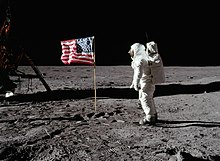
The Apollo program was started byPresidentJohn F Kennedyin the 1960s. The program was made of 16 missions designed to send a man tothe Moonand return him safely back toEarth.The first Apollo mission,Apollo 1,ended in disaster when afirein the command module killed all the astronauts on board.[10]TheApollo 8and10missions went to the moon. They tested equipment and tookphotosbut did not land.
The project's main success came in 1969 whenNeil ArmstrongandBuzz Aldrinlanded on the Moon as part ofApollo 11.The mission was a big success for NASA and over six million people watched it worldwide.[11]After Apollo 11, six more Apollo flights went to the moon. Five of them landed. The one that did not land,Apollo 13,had to abort its mission when anoxygentank exploded in the spaceship.Apollo 17was the last mission to land onthe Moon.
Skylab (1965–1979)[change|change source]

AfterCongressstopped the Moon landings, NASA needed a new direction. Using a leftoverSaturn Vrocket, the giant rocket that sent men tothe Moon,they created a space station that orbited above the Earth. This space station was called Skylab. Skylab was very big on the inside, even bigger than a small house. Skylab was visited by Apollo spacecrafts. There were three missions to Skylab. Each of them carried important experiments. The last crewed mission,Skylab 4,spent 84 days, 1 hour, 15 minutes, 30 seconds, longer than any space mission had spent until 1977. Skylab broke up in the atmosphere in 1979.
Apollo–Soyuz Test Project (1972–1975)[change|change source]
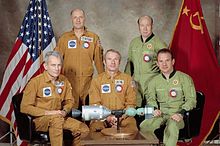
During theSpace Race,the Soviets had designed their own spacecraft to fly tothe Moon.Their spacecraft was calledSoyuz.The Soviets never landed on the Moon, they had too many problems.[12]Instead, they started creating small space stations. The Soyuz spacecraft is what they used to go to these space stations. US and Soviet Union were part of theCold War.In order to make peace between Soviet Union and US, they decided they would dock an Apollo spacecraft to a Soyuz spacecraft in space. After docking, the crews performed experiments and learned about each other's cultures. Apollo–Soyuz was the last flight of the Apollo spacecraft. It has never been used since, and as of 2020, there are no plans for it to be used again.
Space Shuttle program (1972–2011)[change|change source]
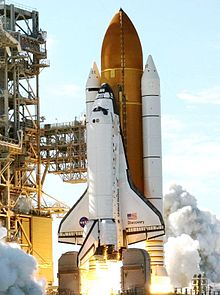
In the1980sand1990sNASA began to concentrate on buildingSpace Shuttles.Four Shuttles were built in 1985. The first to launch was theSpace Shuttle Columbiaon April 12, 1981. At this time the public began to lose interest in the space program and NASA facedbudget cuts.They had planned for the Space Shuttles to cost less as they could be used more than once. But eventually it turned out the Space Shuttles were more expensive as building them in the first place cost more money than normal. There were further problems for NASA after theSpace Shuttle Challengerdisintegrated in flight in 1986, killing all seven of its astronauts. The incident is known as theChallenger Disaster.
The Challenger Disaster forced NASA to think about the way they worked. The entire Space Shuttle fleet was suspended for a year.[13]After that, NASA launched theHubble Space Telescopeinto orbit. Its most famous photo was theHubble Deep Field.[14]
In 2011, NASA shut down the Space Shuttle program. They were more expensive to use than other launch vehicles.
International Space Station (1993–present)[change|change source]

In the early 1980s, NASA planned Space Station Freedom as acounterpartto the SovietSalyutandMirspace stations. It never left the drawing board and, with the end of theSoviet Unionand theCold War,it was cancelled. The end of theSpace Raceprompted the U.S. administration officials to start negotiations with international partners Europe, Russia, Japan and Canada in the early 1990s in order to build the International Space Station. This project was first announced in 1993 and was called Space Station Alpha.[15]It was planned to combine the proposed space stations of all participating space agencies: NASA's Space Station Freedom, Russia'sMir-2(the successor to the Mir Space Station, the core of which is now Zvezda) and ESA'sColumbusthat was planned to be a stand-alone spacelab.
Curiosity rover (2011–present)[change|change source]
Curiosityis acar-sizedrover.It was made toexplorethecrater GaleonMars.Curiositywas launched fromCape Canaveralon November 26, 2011, at 15:02 UTC and landed onAeolis Palusinside Gale on Mars on August 6, 2012, 05:17 UTC. TheBradbury Landingsite was less than 2.4 kilometres (1.5 miles) from where the rover landed after a 560 million kilometres (350 million miles) journey. The goals of the rover include aninvestigationof the Martianclimateandgeology.
Artemis program[change|change source]
Artemis 1was a flight that landed in December 2022. The flight was to test theOrion Space Capsulefor Artemis missions in the future. (SeeOrion (spacecraft).) Artemis missions are later supposed to haveastronauts.
Peregrine Mission One[change|change source]
Peregrine Mission Onewas launched in January 2024.
NASA's future[change|change source]

- TheArtemis 2mission, isscheduledto launch in 2025's third quarter. The spaceship is supposed to do aflybyof the Moon. The choice of astronauts (as of 2024's second quarter)
- Artemis 3,it is supposed to land a crew on the Moon. The mission depends on a support mission to put aStarship Human Landing System(HLS) in place in anear-rectilinear halo orbitof the Moon. TheSLSwithOrion (spacecraft)will be part of Artemis 3.
- Artemis 4,it is supposed to land a crew on the Moon, no earlier than September 2028.
- Artemis 5,it is supposed to land a crew on the Moon, no earlier than September 2029. "Blue Origin[...] was chosen [... in 2023] to develop the landing system for Artemis "5.[17]
In early 2010, PresidentBarack Obamacancelled the Constellation project that was aiming to have humans return to the moon's surface by 2020.[18]He said the project was "behind schedule andlackingininnovation".[18]At the same time he cut back the amount of money NASA will be getting from the government in 2011.[19]
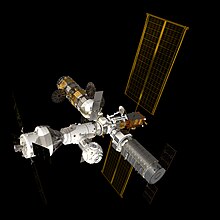
When PresidentBarack Obamadid this, he also worked with NASA to create theSpace Launch System.This, with commercial launch vehicles (launch vehiclesthat are not owned by NASA), will take humans to theMoon,MarsandCeres.[20][21]
In 2069, NASA plans to send aspace probetoAlpha Centauri,the closest star system to the Sun. The proposed launch would be on the 100th anniversary of the first Moon landing,Apollo 11.[1]
NASA is continuing operations include missions to theplanetsMars,SaturnandPluto.Missions toJupiterare also planned for the future.[22]
NASA Missions[change|change source]
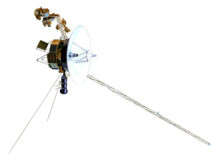
NASA has launched over 500 missions. Over 150 missions hadhumanson board. Suchmannedmissions are the most expensive and make the most news but the majority of launches are forspace exploration,science, and other purposes that do not need people. NASAspacecraftsuch asCassini-Huygensand theVoyager programhave visited everyplanetin theSolar System.Four NASA spacecraft have left the Solar System,Voyager 1,Voyager 2,Pioneer 10andPioneer 11,while the fifth, aNew Horizons spacecraftis estimated to exit the solar system by 2048. As of 2022 Voyager 1 is 23,447,000,000 (23.4 billion)kilometersaway fromEarthandVoyager 2was at a distance 19,474,000,000 (19.4 billion) kilometres away from Earth.[23]
TheNew Horizonsspacecraftflew pastJupiterin February 2007, studying some of the planet'smoons.On July 14, 2015 the craft flew by Pluto, took high resolution pictures of the planet's surface and analysed thechemicalproperties of itsatmosphere.
Use of the metric system[change|change source]
Like other scientific organizations, NASA conducts most of its measurements in the international system (metric system). This is partially due to federal law requiring that most US government programs be done in the international system. In the 1980s, NASA transitioned to the metric system, but was still using US customary \ imperial units into the 1990s. In September 1999, amixup(or mistake) between imperial and metric units resulted in the loss of theMars Climate Orbiter.
Related pages[change|change source]
- Administrators and Deputy Administrators of NASA
- Cape Canaveral Air Force Station
- Kennedy Space Center
Notes[change|change source]
- ↑NASA is an independent agency that is not a part of anyexecutive department.However, it reports directly to thePresident.[5][6]
References[change|change source]
- ↑US Centennial of Flight Commission, NACAArchivedFebruary 20, 2014, at theWayback Machine.centennialofflight.net. Retrieved on November 3, 2011.
- ↑2.02.1Lale Tayla & Figen Bingul (2007)."NASA stands 'for the benefit of all.'—Interview with NASA's Dr. Süleyman Gokoglu".The Light Millennium.Archivedfrom the original on October 12, 2007.RetrievedSeptember 17,2018.
- ↑"Workforce Profile".NASA.Archivedfrom the original on February 14, 2013.RetrievedApril 23,2018.
- ↑Casey Dreier (February 15, 2019)."NASA just got its best budget in a decade".The Planetary Society.Archived fromthe originalon February 16, 2019.RetrievedFebruary 15,2019.
- ↑"Official US Executive Branch Web Sites – Newspaper and Current Periodical Reading Room (Serial and Government Publications Division, Library of Congress)".loc.gov.RetrievedMay 24,2016.
- ↑"Frequently Asked Questions".hq.nasa.gov.Archived fromthe originalon May 4, 2016.RetrievedMay 24,2016.
- ↑"The National Aeronautics and Space Act".NASA. 2005.Retrieved2008-07-10.
- ↑Erickson, Mark (2005).Into the Unknown Together - The DOD, NASA, and Early Spaceflight(PDF).ISBN978-1-58566-140-4.Archived fromthe original(PDF)on March 8, 2003.
- ↑"Wernher von Braun in SS uniform".reformation.org. Archived fromthe originalon 2019-09-23.Retrieved2008-07-13.
- ↑"Apollo 1 - A history of NASA".Retrieved2008-07-14.
- ↑"Publications of the Astronomical Society of Australia"(PDF).CSIRO.Retrieved2008-07-13.
- ↑"Soviet Lunar Landing".Encyclopaedia Astronautica.Retrieved2019-05-18.
- ↑"NASA Shuttle Fleet Grounded after Challenger explosion".wsws.org.
- ↑"Hubble Deep Field - The most important image ever taken?".Deep Astronomy.Archived fromthe originalon 2008-04-10.
- ↑GAO (June 1994)."Space Station: Impact of the Expanded Russian Role on Funding and Research"(PDF).GAO.Retrieved2006-11-03.
- ↑https://www.nrk.no/urix/disse-fire-skal-til-manen-1.16362623.NRK.no. Retrieved 2023-04-03
- ↑https://www.proactiveinvestors.com/companies/news/1015588/blue-origin-scores-3-4b-nasa-contract-for-artemis-v-moon-landing-1015588.html.Retrieved 2023-05-19
- ↑18.018.1"Obama cancels space program".BBC News.Retrieved2010-02-06.
- ↑"Slashed NASA budget leaves the US no longer a space leader".Chron.com. 7 February 2010.
- ↑Stephen Creech (April 2014)."NASA's Space Launch System: A Capability for Deep Space Exploration"(PDF).NASA. Archived fromthe original(PDF)on 2016-03-07.Retrieved2019-03-07.
- ↑"Moon to Mars | NASA".25 June 2018. Archived fromthe originalon 2019-05-22.Retrieved2019-05-23.
- ↑"BBC Mission guide: New Horizons".BBC.Retrieved2008-07-14.
- ↑Spaceflight, Mike Wall 2013-09-13T09:09:40Z (13 September 2013)."Interstellar Traveler: NASA's Voyager 1 Probe On 40,000-Year Trek to Distant Star".Space.com.Retrieved2019-03-07.
{{cite web}}:CS1 maint: numeric names: authors list (link)
Other websites[change|change source]
- NASA.gov- official website
- NASA Television
- NASA PhotosArchived2010-11-12 at theWayback Machine
- How NASA works
- NASA for KidsArchived2021-04-17 at theWayback Machine
- NASA Spaceflight news site
